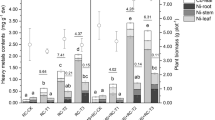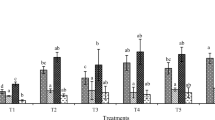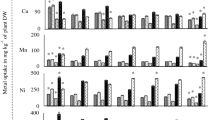Abstract
The substrate of mushroom can be polluted with heavy metals and subsequently contaminate mushroom, which requires alternative solutions to reduce associated environmental and human health risks. The effects of amendment application on alleviating Cu and Cd toxicities to Pleurotus cornucopiae were investigated in a cultivated bag experiment conducted with the naturally contaminated substrate. Addition of combined amendments (sodium bentonite, silicon fertilizer, activated carbon, and potassium dihydrogen phosphate) increased the P. cornucopiae biomass and substrate pH. Cu and Cd concentration in P. cornucopiae as well as the available Cu and Cd in substrate reduced for the presence of amendments, and the silicon fertilizer had the biggest inhibition on metal uptake. The smallest amount of Cu and Cd in P. cornucopiae was only 30.8 and 5.51 % of control, respectively. Moreover, application of amendments also decreased malondialdehyde (MDA) and hydrogen peroxide (H2O2) level in metal-stressed mushroom by 4.38–53.74 and 8.90–58.42 % relative to control, respectively. The decreased oxidative stress could well contribute to the growth of P. cornucopiae, and the elevated substrate pH might lead to the lower metal availability, thus resulting in the reduction of metal accumulation in mushroom. These above results suggest that application of combined amendments in mushroom substrate could be implemented in a general scheme aiming at controlling metal content in P. cornucopiae.






Similar content being viewed by others
References
Barros L, Ferreira M-J, Queiros B, Ferreira IC, Baptista P (2007) Total phenols, ascorbic acid, β-carotene and lycopene in Portuguese wild edible mushrooms and their antioxidant activities. Food Chem 103:413–419
Çağlarırmak N (2007) The nutrients of exotic mushrooms (Lentinula edodes and Pleurotus species) and an estimated approach to the volatile compounds. Food Chem 105:1188–1194
Chen SB, Xu MG, Ma YB, Yang JC (2007) Evaluation of different phosphate amendments on availability of metals in contaminated soil. Ecotox Environ Safe 67:278–285
Christidis GE, Scott PW, Dunham AC (1997) Acid activation and bleaching capacity of bentonites from the islands of Milos and Chios, Aegean, Greece. Appl Clay Sci 12:329–347
da Cunha KPV, do Nascimento CWA (2009) Silicon effects on metal tolerance and structural changes in maize (Zea mays L.) grown on a cadmium and zinc enriched soil. Water Air Soil Poll 197:323–330
Davezza M, Fabbri D, Prevot AB, Pramauro E (2011) Removal of alkylphenols from polluted sites using surfactant-assisted soil washing and photocatalysis. Environ Sci Pollut R 18:783–789
Guo GL, Zhou QX, Ma LQ (2006) Availability and assessment of fixing additives for the in situ remediation of heavy metal contaminated soils: a review. Environ Monit Assess 116:513–528
Houben D, Pircar J, Sonnet P (2012) Heavy metal immobilization by cost-effective amendments in a contaminated soil: effects on metal leaching and phytoavailability. J Geochem Explor 123:87–94
Jing X-b, He N, Zhang Y, Cao Y-r, Xu H (2011) Isolation and characterization of heavy-metal-mobilizing bacteria from contaminated soils and their potential in promoting Pb, Cu, and Cd accumulation by Coprinus comatus. Can J Microbiol 58:45–53
Komárek M, Vaněk A, Ettler V (2013) Chemical stabilization of metals and arsenic in contaminated soils using oxides—a review. Environ Pollut 172:9–22
Kováčik J, Babula P, Hedbavny J, Švec P (2014) Manganese-induced oxidative stress in two ontogenetic stages of chamomile and amelioration by nitric oxide. Plant Sci 215:1–10
Kumpiene J, Lagerkvist A, Maurice C (2008) Stabilization of As, Cr, Cu, Pb and Zn in soil using amendments—a review. Waste Manage 28:215–225
Li Q, Liang ZJ, Ge F, Xu Y, Yang L, Zeng H (2014) Alleviating CTAC and Flu combined pollution damage in Chlorella vulgaris by exogenous nitric oxide. Chemosphere 96:39–45
Liang YC, Sun WC, Zhu YG, Christie P (2007) Mechanisms of silicon-mediated alleviation of abiotic stresses in higher plants: a review. Environ Pollut 147:422–428
Liang XF, Han J, Xu YM, Sun YB, Wang L, Tan X (2014) In situ field-scale remediation of Cd polluted paddy soil using sepiolite and palygorskite. Geoderma 235:9–18
Ma JF, Yamaji N (2006) Silicon uptake and accumulation in higher plants. Trends Plant Sci 11:392–397
Madrid F, Romero AS, Madrid L, Maqueda C (2006) Reduction of availability of trace metals in urban soils using inorganic amendments. Environ Geochem Hlth 28:365–373
Maslin P, Maier RM (2000) Rhamnolipid-enhanced mineralization of phenanthrene in organic-metal co-contaminated soils. Biorem J 4:295–308
Mohan D, Singh KP (2002) Single-and multi-component adsorption of cadmium and zinc using activated carbon derived from bagasse—an agricultural waste. Water Res 36:2304–2318
Mouni L, Merabet D, Bouzaza A, Belkhiri L (2011) Adsorption of Pb (II) from aqueous solutions using activated carbon developed from Apricot stone. Desalination 276:148–153
Notarachille G, Arnesano F, Calo V, Meleleo D (2014) Heavy metals toxicity: effect of cadmium ions on amyloid beta protein 1-42 Possible implications for Alzheimer’s disease. Biometals 27:371–388
Park JH, Bolan NS, Chung JW, Naidu R, Megharaj M (2011) Environmental monitoring of the role of phosphate compounds in enhancing immobilization and reducing bioavailability of lead in contaminated soils. J Environ Monitor 13:2234–2242
Raicevic S, Kaludjerovic-Radoicic T, Zouboulis AI (2005) In situ stabilization of toxic metals in polluted soils using phosphates: theoretical prediction and experimental verification. J Hazard Mater 117:41–53
Rizwan M, Meunier J-D, Miche H, Keller C (2012) Effect of silicon on reducing cadmium toxicity in durum wheat (Triticum turgidum L. cv. Claudio W.) grown in a soil with aged contamination. J Hazard Mater 209:326–334
Rogalla H, Romheld V (2002) Role of leaf apoplast in silicon-mediated manganese tolerance of Cucumis sativus L. Plant, Cell Environ 25:549–555
Rosa M, Prado F, Hilal M, Pagano E, Prado C (2014) Phytoremediation: strategies of Argentinean plants against stress by heavy metals. In Bioremediation in Latin America, pp 123-134. Springer
Ruttens A, Mench M, Colpaert J, Boisson J, Carleer R, Vangronsveld J (2006) Phytostabilization of a metal contaminated sandy soil. I: influence of compost and/or inorganic metal immobilizing soil amendments on phytotoxicity and plant availability of metals. Environ Pollut 144:524–532
Saeed A, Sohail M, Rashi N (2014) Effects of heavy metals toxicity on the biochemical response in tomato plants grown in contaminated silt-soil. Bangladesh J Sci Ind Res 48:229–236
Sanchez-Monedero MA, Roig A, Paredes C, Bernal MP (2001) Nitrogen transformation during organic waste composting by the Rutgers system and its effects on pH, EC and maturity of the composting mixtures. Bioresource Technol 78:301–308
Singh S, Sinha S, Saxena R, Pandey K, Bhatt K (2004) Translocation of metals and its effects in the tomato plants grown on various amendments of tannery waste: evidence for involvement of antioxidants. Chemosphere 57:91–99
Singh HP, Batish DR, Kaur G, Arora K, Kohli RK (2008) Nitric oxide (as sodium nitroprusside) supplementation ameliorates Cd toxicity in hydroponically grown wheat roots. Environ Exp Bot 63:158–167
Song A, Li Z, Zhang J, Xue G, Fan F, Liang Y (2009) Silicon-enhanced resistance to cadmium toxicity in Brassica chinensis L. is attributed to Si-suppressed cadmium uptake and transport and Si-enhanced antioxidant defense capacity. J Hazard Mater 172:74–83
Tica D, Udovic M, Lestan D (2011) Immobilization of potentially toxic metals using different soil amendments. Chemosphere 85:577–583
Tomasevic DD, Kozma G, Kerkez DV, Dalmacija BD, Dalmacija MB, Becelic-Tomin MR, Kukovecz A, Konya Z, Roncevic S (2014) Toxic metal immobilization in contaminated sediment using bentonite- and kaolinite-supported nano zero-valent iron. J Nanopart Res 16
Turkoglu A, Duru ME, Mercan N, Kivrak I, Gezer K (2007) Antioxidant and antimicrobial activities of Laetiporus sulphureus (Bull.) Murrill. Food Chem 101:267–273
Vaculik M, Lux A, Luxova M, Tanimoto E, Lichtscheidl I (2009) Silicon mitigates cadmium inhibitory effects in young maize plants. Environ Exp Bot 67:52–58
Valentao P, Lopes G, Valente M, Barbosa P, Andrade PB, Silva BM, Baptista P, Seabra RM (2005) Quantitation of nine organic acids in wild mushrooms. J Agr Food Chem 53:3626–3630
Wasser SP, Weis AL (1999) Medicinal properties of substances occurring in higher basidiomycetes mushrooms: current perspectives (review). International Journal of medicinal mushrooms 1
Yang X (1986) Cultivation of edible mushroom in China. Agriculture Printing House, Beijing, PR China, pp 489–510
Zeng F, Ali S, Zhang H, Ouyang Y, Qiu B, Wu F, Zhang G (2011) The influence of pH and organic matter content in paddy soil on heavy metal availability and their uptake by rice plants. Environ Pollut 159:84–91
Zhang RH, Li XJ, Fadel JG (2002) Oyster mushroom cultivation with rice and wheat straw. Bioresour Technol 82:277–284
Zhou H, Zhou X, Zeng M, Liao B-H, Liu L, Yang W-T, Wu Y-M, Qiu Q-Y, Wang Y-J (2014) Effects of combined amendments on heavy metal accumulation in rice (Oryza sativa L.) planted on contaminated paddy soil. Ecotox Environ Safe 101:226–232
Zhu Y, Yu H, Wang JL, Fang W, Yuan JG, Yang ZY (2007) Heavy metal accumulations of 24 asparagus bean cultivars grown in soil contaminated with Cd alone and with multiple metals (Cd, Pb, and Zn). J Agr Food Chem 55:1045–1052
Acknowledgments
This study was financially supported by the Science and Technology Program for Public Wellbeing of Chengdu (2014-HM01-00163-SF), the Science and Technology Innovation Seedling Project of Sichuan Province (2015RZ0019), the Patent Implementation and Promotion Project of Sichuan Province, the Science and Technology Development Project of Infinitus (China) Company Ltd., and the NSFC (No. J1103518). The authors also wish to thank Professor Guanglei Cheng and Dong Yu from Sichuan University for their technical assistance.
Author information
Authors and Affiliations
Corresponding author
Additional information
Responsible editor: Philippe Garrigues
Hongying Liu and Shanshan Guo contributed equally to this work.
Rights and permissions
About this article
Cite this article
Liu, H., Guo, S., Jia, Z. et al. Alleviating the toxicity of heavy metals by combined amendments in cultivated bag of Pleurotus cornucopiae . Environ Sci Pollut Res 22, 17182–17191 (2015). https://doi.org/10.1007/s11356-015-4941-5
Received:
Accepted:
Published:
Issue Date:
DOI: https://doi.org/10.1007/s11356-015-4941-5




